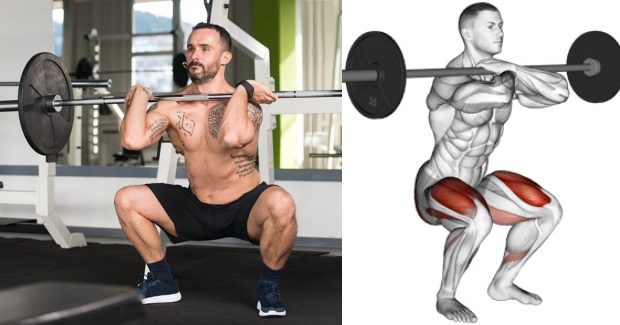The Front Squat, also known as a Barbell Front Squat, is simply a squat done with the barbell on your front shoulders instead of on your upper-back.
The Front Squat involves the quadriceps, hamstrings, calves, lower back and glute muscles. The Front Squat is one of the most effective exercises for targeting the quadriceps and at the same time strengthening your entire core. The Front Squat also minimises spinal compression and therefore places less stress on your lower back.
Quadriceps Muscle Physiology Summary
Quadriceps (quads) is large group of muscles on the front of the upper leg, often referred to as the thighs. This is the strongest and leanest muscle in the human body. The Quadriceps are so named because they are a group of four different muscles:
- The Rectus femoris occupies the middle of the thigh, covering most of the other three quadriceps muscles. It originates on the ilium. It is named from its straight course.
- The Vastus intermedius lies between vastus lateralis and vastus medialis on the front of the femur (i.e. on the top or front of the thigh).
- The Vastus medialis is on the medial side of the femur (i.e. on the inner part thigh).
- The Vastus lateralis is on the lateral side of the femur (i.e. on the outer side of the thigh).

Quadriceps run along the front of the thigh, starting at the hip joint and ending at the knee joint. All four parts of the quadriceps muscle attach to the patella (knee cap) via the quadriceps tendon.
The primary function is to flex the hip and extend the knee, very important in walking, running, jumping, climbing, and pedalling.
Correct Exercise Procedure Use for Barbell Front Squat
- Adjust the pins in the squat rack so the bar will rest at about shoulder height.
- Cross your arms in front of your body parallel to the floor and rest the bar across the front of your shoulders.
- Lift the bar off the rack and take a step back.
- With your feet approximately shoulder width apart, toes pointing slightly outward, back straight, abs tight, head up looking forward, begin movement by squatting toward the floor.
- Lower yourself until your thighs are parallel to the floor.
- Drive the weight back up to the starting position until knees are about to lock out.
- Repeat until the desired number of reps have been completed then re-rack the bar.

Tips for Performing Front Squat
By using the tips mention below will help for the muscle(s) full development by incorporating more muscle fibres per rep, thus increasing the muscle’s size and strength.
- Practice proper form and control. Starting with this exercise, or any exercise you have not performed before, use light weight until you have the full range of movement with proper extension and contraction completed. This is important for the muscles full development.
- Grab barbell with both hands. For beginners you can grab the barbell with both hands instead of crossing your arms. This will help until you become accustom to the distribution of weight.
- Do not overload on weight. When you first try the barbell front squat do not overload the weight, the centere of gravity is no longer behind you as in the traditional squat.
- Keep your back straight and head up. Keeping your head up and back straight will help prevent you from leaning or falling forward.
- Keep your feet flat and pointed forward. Make sure your feet are flat on floor, pointed forward and aligned with your knees in order to help keep the weight distributed evenly.
- Avoid locking out knees. Avoid locking out your knees and allowing muscles to relax before next repetition.
- Stop one rep short of failure. Taking this exercise to all-out failure can be potentially dangerous. I recommend that you stop your set one rep short of failure and safely re-rack the bar.

Frequent Mistakes Made While Performing Front Squat
Performing the exercise improperly, often referred to as cheating, will not allow for the muscle and muscle fibres to use their fullest potential, resulting in not achieving desired development of the muscle.
- Movement performed too fast. If movement is perform too fast, with a jerky motion or using body momentum will not allow full usage of all muscle fibres.
- Locking your knees. By locking your knees out while in the standing position will take the stress off your quads and add stress on your joints.
- Failure to keep head up and back straight. Failure to keep your head up and back straight may cause you to fall forward with the barbell. It can also cause you to lean forward, placing extra stress on the back and joints in your knees, which over time; can lead to spinal problems and degeneration of the knees.
- Limiting the range of motion. Many lifters do not go all the way down or do not squeeze at the top of the movement. If full range of motion is not use, less muscle fibre will be worked and less growth will occur.
- Using too much weight. A front squat is a very awkward exercise to perform at first. Make sure you start out with light weight in order to get a proper feel for the lift before moving to a heavier weight.

